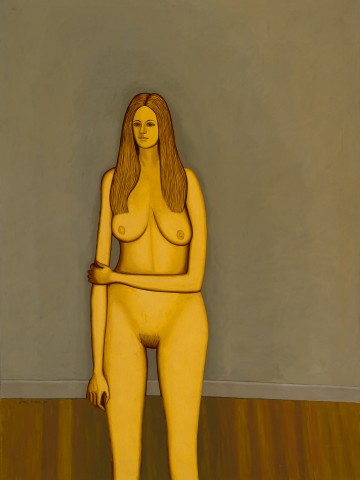STANDING NUDE, 1970
JOHN BRACK
oil on canvas
129.5 x 96.5 cm
signed and dated lower left: John Brack 70
inscribed with title on artist’s label verso: STANDING NUDE
Rudy Komon, Sydney (bears inscription on artist’s label verso: Rudy)
The Estate of Rudy Komon, Sydney
Ray Hughes, Sydney (label attached verso)
Private collection, New South Wales, acquired from the above c.1996
John Brack, Rudy Komon Gallery, Sydney, 7 – 28 April 1971, cat. 5 (label attached verso, stock no. 2855)
The Private Collection of Mr and Mrs Rudy Komon, Georges Gallery, Melbourne, 9 – 21 August 1971
Grishin, S., The Art of John Brack, Oxford University Press, Melbourne, 1990, vol. I, p. 117; vol. II, cat. o183, pp. 25, 142 (illus.)
Lindsay, R., John Brack, A Retrospective Exhibition, National Gallery of Victoria, Melbourne, 1987, p.125
The female nude is a consistent subject throughout John Brack’s oeuvre, first appearing in an important group of paintings made during the late 1950s and continuing through to the last decades of his career. The history of art remained an essential touchstone for Brack and the significance of the nude – as well as other traditional genres such as still-life and portraiture – from Boucher’s famous L’Odalisque, c.1745 (Musée du Louvre, Paris) to Manet’s Olympia, 1863 (Musée d’Orsay, Paris), provided both inspiration and challenge as he borrowed from the masters and pitted himself against them. Underlying this was Brack’s enduring interest in the human condition, which he described in this context, saying: ‘When I paint a woman … I am not interested in how she looks sitting in the studio, but in how she looks at all times, in all lights, what she looked like before and what she is going to look like, what she thinks, hopes, believes, and dreams. The way the light falls and casts its shadows is merely … a hindrance unless it helps me to show these things.’1
Confronted by the fact that that ‘there is absolutely nothing whatsoever erotic in an artist’s model unclothed in a suburban empty room’2, Brack’s earliest nudes aimed to de-eroticise the subject, thereby subverting one of the primary expectations of the genre. Later nudes of the 1970s and 80s reveal a certain sensuality and one senses the artist’s pleasure in depicting the female form, but viewed as a group, these works also express more universal ideas about women and their place in the world. Helen Brack has described the recurring focus on the (always) female nude as ‘John’s need for discipline in seeing and depicting, and his constant effort to define how women are’.3
Painted in his studio with its timber floorboards and unadorned walls, the late nudes typically depict a woman (occasionally two) with various props; a chair, sometimes draped with the model’s discarded robe, and more often than not, a Persian carpet. Rendered in intricate detail, the carpets have a prominent role in Brack’s nudes, as do the floorboards, which often tilt vertiginously, as if everything they support might fall over at any moment. Eschewing all of these familiar accoutrements, Standing Nude, 1970 is one of Brack’s most austere paintings. The focus is on the young woman who stands at the very front of the picture plane, one arm folded across her body holding the other, a gesture which implies some awkwardness but also reinforces the strongly rectilinear nature of the composition. It was included in Brack’s 1971 solo exhibition at the Rudy Komon Gallery, Sydney, alongside Reclining Nude, 1970 (Art Gallery of South Australia) and The Fur Coat, 1971 (Queensland Art Gallery/Gallery of Modern Art). While the Bulletin review of the exhibition asked ‘What Has Happened to the Nude?’4, Daniel Thomas looked beyond the surface, writing, ‘In the new nudes he reminds us that we are looking at paintings, not people … Besides the tension between real and artificial, I now think there’s a permanent tension between puritanism and luxury in his work. Spare puritan forms always, luxurious subject matter mostly’.5 Standing Nude was acquired by Rudy Komon and later owned by Ray Hughes, and its provenance, as part of the personal collections of two of Sydney’s most renowned art dealers – both individuals with a very well-trained eye – highlights its pictorial strength and significance within Brack’s oeuvre.
1. Brack, H., ‘This Oeuvre – The Work Itself’, Grant, K., John Brack, exhibition catalogue, National Gallery of Victoria, Melbourne, 2009, p. 16
2. See Grant, K., ibid., p. 87
3. Brack, J. interviewed in Australian Contemporary Art Archive, no. 1, Deakin University Media Production, 1980, transcript, p. 3
4. Lynn, E., ‘What Has Happened to the Nude?’, Bulletin, Sydney, 24 April 1971, pp. 54-55
5. Thomas, D., ‘Display of Nudes’, Sunday Telegraph, Sydney, 11 April 1971
KIRSTY GRANT
